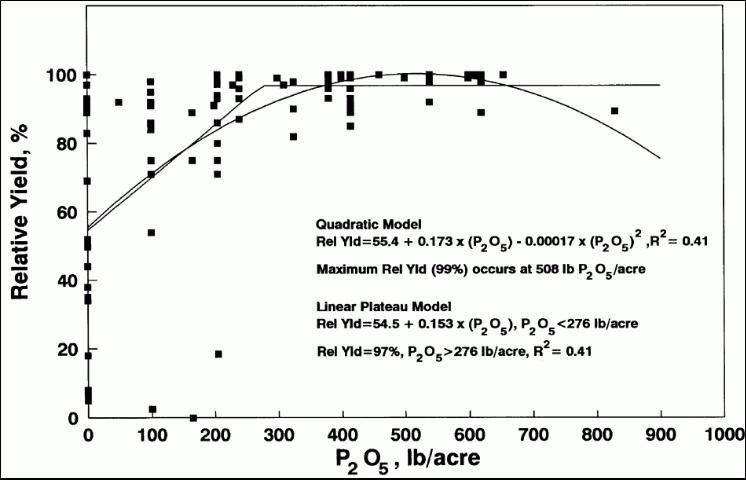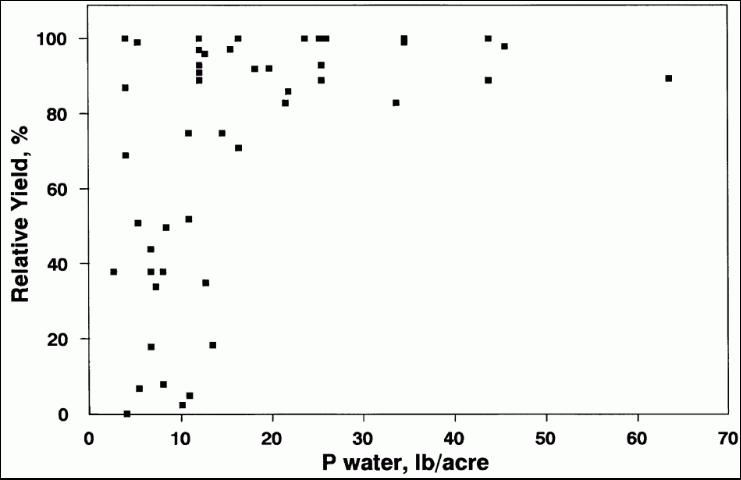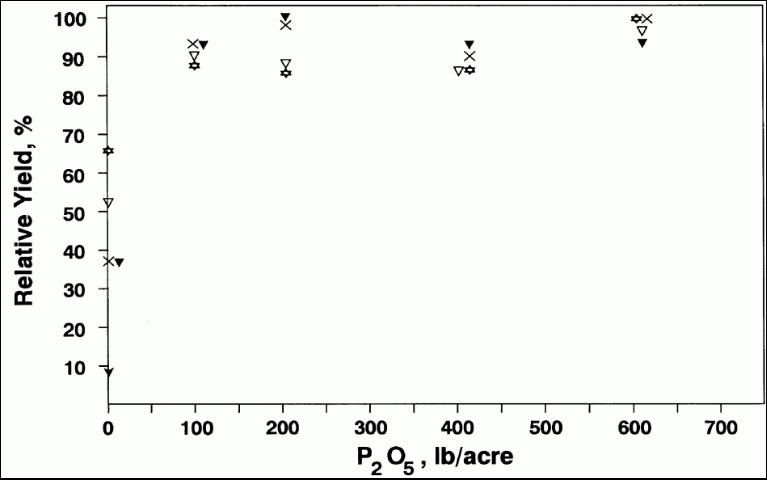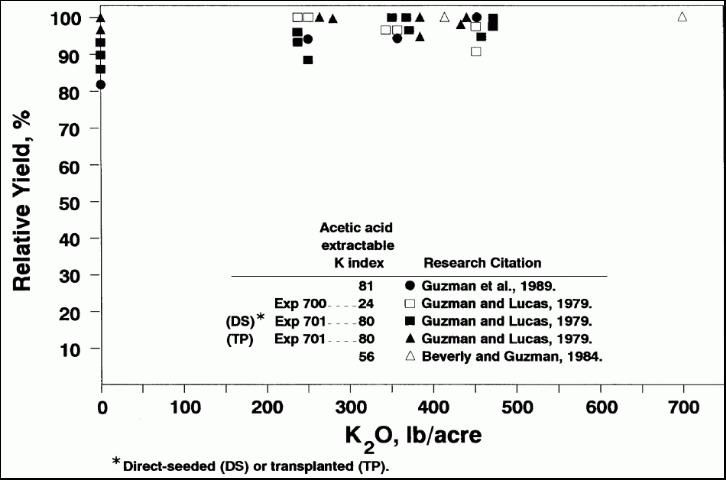This publication is intended for Florida vegetable growers and others interested in lettuce production in the state. Lettuce (Lactuca sativa L.) is planted on 10,000 acres in Florida with about 80% of the crop grown in the Everglades Agricultural Area (EAA) (https://wwwnass.usda.gov/Statistics). The farm gate value of Florida lettuce is $70–$80 million annually.
Crisphead lettuce made up about 3,000 acres of this lettuce production. The average crisphead lettuce yield is estimated to be 600 fifty-pound cartons per acre.
Crisphead lettuce is a moderately expensive crop to produce with fertilizer being one of the major inputs. Considerable research has been conducted on lettuce fertilization on the organic soils of Florida with emphasis on the EAA. Optimum fertilization is important for maximizing yields and quality and for minimizing negative environmental impacts due to overfertilization.
This publication presents UF/IFAS recommendations for fertilization of crisphead lettuce on organic soils in Florida. Recommendations are based on field research and supersede those found in Bulletin 876 (Sanchez 1990), Circular 806 (Hochmuth and Hanlon 1989), and Circular 123C (Montelaro 1977). Reviewing and updating fertilization recommendations is a continuing process.
Organic Soils
The organic (muck) farmlands in southern Florida originated from the drainage of marshes consisting largely of decomposing sawgrass. Upon decomposition of the organic matter, nutrients are released (mineralized), becoming available for plant uptake. Mineralization does not supply all of the nutrition required by lettuce. Lettuce is produced in southern Florida in the winter season. During the cool winter growing period, mineralization is not rapid enough to supply adequate nutrients to a rapidly growing lettuce crop.
The soil pH of the EAA has increased with time (Wright et al. 2018). As a result of increased soil pH, the availability of phosphorus and some micronutrients to lettuce plants is reduced. Fertilization is needed to meet the portion of the lettuce nutrient requirement made unavailable by high pH and to supply nutrients that are not present in sufficient amounts from mineralization.
Soil Testing
The soil test calibration and fertilization recommendations outlined in this publication were developed using procedures of the UF/IFAS Everglades Soil Testing Laboratory in Belle Glade, Florida. Recommendations for phosphorus (P) and potassium (K) are based on a soil test. Current methodologies use water as the extractant for P and 0.5N acetic acid for K (Sanchez 1990). Soil testing provides an index to the portion of the crop nutrient requirements that can be supplied from the soil. Fertilizer is added to supplement the native fertility to obtain positive yield and quality responses. Although the recommendations in this publication are based on the above extractants, work is continuing to improve methodologies (Sanchez and Hanlon 1990), especially in light of the increasing pH of these soils.
Soil testing benefits are related to the quality of the soil sample. Soil samples should reasonably represent the "production unit." The unit might vary in size from 10 acres to 40 acres, depending on the grower's understanding of soil uniformity. Areas not representative of the production unit, such as shallow areas, borders near ditches or roadways, or areas varying from the predominant soil type, should be sampled separately. These areas may need to be managed differently than the rest of the field.
Soil pH
Early research demonstrated that a pH of about 6.0 was desirable for most vegetables (Lucas and Davis 1961). The use of sulfur (S) to acidify organic soils with pH above 6.5 appears to have had merit for vegetables (Lucas and Davis 1961; Burdine and Guzman 1965a; Burdine and Guzman 1965b; Burdine and Guzman 1968; Guzman and Sanchez, 1986a). However, organic soil is highly buffered against pH changes (Beverly and Anderson 1986) such that up to 4,000 lb per acre of S might be needed to reduce the pH from above 6.8 to 6.0 (Sanchez 1990). The grower must weigh the economic benefit of S application because sulfur is expensive and the pH reduction is temporary. Foliar applications of certain micronutrients and band placement of P and micronutrients might be more economically sound alternatives to S application for improving nutrient availability to plants (Beverly and Guzman 1985).
Macronutrients
Nitrogen
Several research reports outlined benefits of N application to crisphead lettuce (Beverly and Guzman 1984; Guzman and Sanchez 1986a; Sanchez et al. 1988a; Sanchez et al. 1988b). The N recommendation for crisphead lettuce is to broadcast up to 50 lb N per acre in cool planting periods. N applications made after planting should be banded into moist soil during the cool period of the growing season or after leaching rains where the soil has been soaked or temporarily flooded.
Growers should avoid the temptation to overfertilize crisphead lettuce with N. Excess N can reduce head quality by lowering firmness or causing splitting. Bottom-rot might also be enhanced if warm, moist conditions occur after excess N application.
Phosphorus
Several studies have reported yield responses to P fertilization of crisphead lettuce grown on Florida organic soils (Guzman and Lucas 1979; Lucas and Guzman 1980; Beverly and Guzman 1984; Sanchez et al. 1988a; Sanchez et al. 1988b; Sanchez and Burdine 1988; Guzman et al. 1989; Sanchez et al. 1990a; Sanchez et al. 1990b; Nagata et al. 1992). A linear-plateau model (Dahnke and Olson 1990; Cerrato and Blackmer 1990) and a simple quadratic model were used to describe the data for response to P fertilization (Figure 1). All relative yield values were calculated from reported marketable (not biomass) lettuce yields. The linear-plateau model showed that yield began to level off at 276 lb P2O5 per acre, but the quadratic model did not maximize until 508 lb P2O5 per acre. Other research has shown that quadratic models tend to overestimate plant response to fertilization (Cerrato and Blackmer 1990; Hochmuth et al. 1993). Upper and lower boundaries of lettuce response to P fertilization may be estimated using these two models. A roughly equidistant value between the linear-plateau shoulder and the quadratic maximum (i.e., 400 lb P2O5 per acre) represents a justifiable limit for response to broadcast P.

Credit: Sanchez (1990)
The critical soil-P index above which lettuce would not respond to fertilization with P was set at 27 (Sanchez 1990). Figure 2 shows response of crisphead lettuce on unfertilized soil of varying P water indices from 22 experiments. Figure 2 was constructed by plotting percent relative yield at zero added P versus the soil test index. Nelson and Anderson (1977) proposed a statistical method for grouping soils responsive to fertilization. Graphical (Cate and Nelson 1971) and statistical solutions were calculated for the data in Figure 2. The graphical solution showed that lettuce marketable yield was unlikely to respond to P fertilization of soils testing above a P water index of 15. A statistical solution showed that yield response was unlikely above a P water index of 12. The coefficient of determination for the statistical model was only 0.45, indicating that the initial P water index should not be used as the sole indicator for P fertilization.

Credit: Sanchez (1990)
Significant improvements in P efficiency and improved profitability result from band placement of P fertilizer (Guzman and Sanchez 1987b). Sanchez et al. (1990a), summarized in Figure 3, confirmed these results.

Credit: Sanchez et al. (1990a)
The new UF/IFAS recommendations specify no more than 200 lb P2O5 (banded) per acre, depending on soil test results (Table 1). The P fertilizer should be placed in three-inch-wide bands in the bed, two to three inches below the lettuce rows. Banding liquid fertilizer is equivalent to, or slightly better than, banding granular fertilizers (Guzman et al. 1988; Sellers et al. 1988). Lettuce does not respond to supplemental P sidedressed during the growing season (Sanchez et al. 1990b).
Potassium
Several responses to K fertilization have been documented (Guzman and Lucas 1979; Beverly and Guzman 1984; Guzman et al. 1987; Diaz et al. 1988; Guzman et al. 1989). Figure 4 presents a summary of research on lettuce response to K fertilization. UF/IFAS recommendations specify no more than 200 lb K2O (broadcast) per acre, depending on the soil test (0.5N acetic acid) index value (Table 1). Potassium should be broadcast and incorporated into the bed before planting. Excessive application rates of K, especially banded applications, can cause soluble salt damage to lettuce plants.

Credit: Sanchez (1990)
Calcium, Magnesium, and Sulfur
Supplies of calcium (Ca), magnesium (Mg), and sulfur (S) from organic soils are usually adequate to meet crisphead lettuce nutrient requirements. These nutrients are supplied from the underlying limestone (during irrigation or flooding), from oxidation of the muck, from applied S (for soil acidification), or as a contaminant in fertilizers or certain pesticides.
Sometimes, Ca-related physiological disorders (e.g., tipburn) can occur. Research results on the relation of foliar- and soil-applied Ca to tipburn, cracked stem, and certain head disorders have been mixed (Guzman and Sanchez 1987a), so no clear recommendation can be made. These disorders tend to not be directly related to low soil Ca, but to a temporary inability of the plant to translocate Ca to the young leaves in the lettuce head. A similar problem has been described for cabbage by Palzkill et al. (1976). Calcium moves in the transpiration stream of the plant, so Ca deficiency is related to the plant’s water status. Young leaves inside the lettuce head do not transpire as actively as wrapper leaves. Dry soil conditions, windy periods, excessive soluble salts, and high temperatures create transpirational demands in older leaves such that Ca movement to younger leaves is reduced, thus increasing tipburn. Root pruning during cultivation also can lead to tipburn because young root tips (where Ca is preferentially absorbed) can be damaged. Excess fertilization with N (excessive growth rate) or K (increased soluble salts) can increase internal or external wrapper leaf tipburn.
Micronutrients
There are only a few studies on micronutrient fertilization of crops on organic soils with emphasis on soil test calibration. Current micronutrient recommendations are for an apparent crop need, or are based on soil pH. Micronutrients can be broadcast before planting with the K fertilizer. Research has not evaluated banding of micronutrients. Banding of micronutrients might be more efficient than broadcasting, but rates might need to be reduced to prevent toxicities.
- Manganese (Mn): For pH below 5.7, no Mn is required (Forsee 1940; Forsee 1952; Forsee 1954). For soils above 5.7, 8 lb Mn per acre are recommended using sulfate or finely ground oxide sources.
- Boron (B): For crisphead lettuce, B should be added at 1.0 to 1.5 lb B per acre for each crop. This recommendation is based on apparent crop need and the fact that B can leach from organic soils (Sanchez 1990).
- Copper (Cu): Applications of 12 lb Cu per acre and 4 lb Cu per acre for the first two crops, respectively, on virgin land are usually sufficient for succeeding crops (Forsee 1940; Kretchmer and Forsee 1964). No further Cu fertilization is required (Sanchez 1990).
- Zinc (Zn): The recommendation is for 8 lb Zn per acre, based on apparent crop requirement (Sanchez 1990).
- Iron (Fe): Deficiencies of Fe are rare in Florida vegetables grown on organic soils. No general recommendation for Fe fertilizer exists.
Foliar Micronutrients
Occasionally, micronutrient deficiencies appear in lettuce during cool or wet weather. However, some crops (even in fields with high pH) do not respond to soil-applied micronutrients. There appears to be some benefit to foliar application of some micronutrients (Beverly and Guzman 1985). Recommendations for foliar micronutrient applications are in Table 2.
Water Management
Irrigation and fertilization programs should be managed together for highest efficiency and minimal nutrient movement. Water tables should not be maintained above what is required to supply optimum moisture in the root zone. Overirrigation or excessive water table fluctuation can lead to nutrient leaching. Water tables can be monitored using observation wells with graduated floats.
Plant Tissue Analyses
Analysis of lettuce leaves can provide information to help manage fertilizer more efficiently or diagnose a suspected deficiency. Table 3 presents an interpretation of nutrient levels for crisphead lettuce.
Lettuce Fertilization Recommendations
- Soil pH: Target pH is 6.0. However, crop yield will not be sacrificed over a pH range of 5.0 to 6.5. At an appreciably higher pH, banding of P and foliar applications of needed micronutrients may be preferable to pH reduction attempts using S or other acid-forming amendments.
- Nitrogen: Broadcast up to 50 lb N per acre in cool planting periods.
- Phosphorus: Phosphorus recommendations are based on a water extraction procedure. The maximum P recommendation (Pw < 3 lb per acre) is for 200 lb P2O5 per acre, banded (Table 1).
- Potassium: Potassium recommendations are based on acetic acid extraction procedure. The maximum K recommendation (KOAC < 50 lb K per acre) is for 200 lb K2O per acre, broadcast (Table 2).
References
Beverly, R. B., and V. L. Guzman. 1984. "N, P, K Rates on Yield and Quality of Crisphead Lettuce." Belle Glade EREC Vegetable Field Day Report. 31–34.
Beverly, R. B., and V. L. Guzman. 1985. "Lettuce Varietal Response to Soils and Foliar Nutritional Applications on Terra Ceia Muck." Soil Crop Sci. Soc. Fla. Proc. 44:88–90.
Beverly, R. B., and D. L. Anderson. 1987. "Effects of Acid Source on Soil pH." Soil Sci. 143:301–303.
Burdine, H. W., and V. L. Guzman. 1965a. "The Response of Some Green Celery Varieties to pH Adjustment with Sulfur on Everglades Organic Soil." Proc. Fla. State Hort. Soc. 78:148–155.
Burdine, H. W., and V. L. Guzman. 1965b. "Response of Escarole to pH Adjustment and Some Other Nutritional Factors on New Sawgrass Peat." Univ. Fla. Belle Glade EREC Res. Rpt. EV-65-6.
Burdine, H. W., and V. L. Guzman. 1968. "Some Soil pH Effects on Soil Test and Growth of Some Vegetable Crops on Everglades Organic Soil." Univ. Fla. Belle Glade EREC Res. Rpt. EV-68-9.
Cate, R. B., Jr., and L. A. Nelson. 1971. "A Simple Statistical Procedure for Partitioning Soil Test Correlation Data into Two Classes." Soil Sci. Soc. Am. Proc. 35:658–659. https://doi.org/10.2136/sssaj1971.03615995003500040048x
Cerrato, M. E., and A. M. Blackmer. 1990. "Comparison of Models for Describing Corn Yield Response to Nitrogen Fertilizer." Agron. J. 82:138–143. https://doi.org/10.2134/agronj1990.00021962008200010030x
Dahnke, W. C., and R. A. Olson. 1990. "Soil Test Correlation, Calibration, and Recommendation." In Soil Testing and Plant Analysis, Third Edition, edited by R. L. Westerman. 45–71. Madison, WI: Soil Sci. Soc. Amer. Inc. https://doi.org/10.2136/sssabookser3.3ed.c4
Diaz, O. A., E. A. Hanlon, Jr., G. J. Hochmuth, and J. M. White. 1988. "Phosphorus and Potassium Nutrition of Lettuce on a Florida Muck." Soil Crop Sci. Soc. Fla. Proc. 47:36–41.
Forsee, W. T. 1940. "Recent Plant Responses to Some Micronutrient Deficiencies on Everglades Peat." Soil Sci. Soc. Fla. Proc. 2:53–58.
Forsee, W. T. 1952. "Minor Element Deficiencies and Field Correction Established by Research in Florida Vegetables." Proc. Fla. State Hort. Soc. 65:154–159.
Forsee, W. T. 1954. "Conditions Affecting the Availability of Residual and Applied Manganese in the Organic Soils of the Florida Everglades." Soil Sci. Soc. Fla. Proc. 20:316–323.
Guzman, V. L., and R. E. Lucas. 1979. "Preliminary Investigations on the Nutrient Requirements of Crisp-Head Lettuce Cultivars." Univ. Fla. Belle Glade EREC Res. Rpt. EV-1979-4:1–15.
Guzman, V. L., and C. A. Sanchez. 1986a. "The Response of Lettuce to Fertility Level and Banded S, Mn, and P." Univ. Fla. Belle Glade EREC Res. Rpt. EV-1986-8:24–33.
Guzman, V. L., and C. A. Sanchez. 1986b. "Response of Lettuce to Fertility Level and N Fertilization Practice." Univ. Fla. Belle Glade Research Report EV-1986-8:17–23.
Guzman, V. L., C. A. Sanchez, and R. E. Lucas. 1987. "Banding Fertilizers for Improved Fertilizer Use Efficiency for Lettuce on Everglades Histosols." Proc. Fla. State Hort. Soc. 100:200–203.
Guzman, V. L., and C. A. Sanchez. 1987a. "The Effects of Soil and Foliar Applied Ca on Diseases and Disorders Which Affect the Quality of Lettuce." Univ. Fla. Belle Glade EREC Res. Rpt. EV-1987-3:17–24.
Guzman, V. L., and C. A. Sanchez. 1987b. "Banding Fertilizers for Improved Fertilizer Use Efficiency for Lettuce on Everglades Histosols." Univ. Fla. Belle Glade Research Report EV-1987-3:24–32.
Guzman, V. L., C. A. Sanchez, and R. T. Nagata. 1988. "Banding Liquid vs. Granular Fertilizers for Crisphead Lettuce Production in Organic Soils." Univ. Fla. Belle Glade EREC Res. Rpt. EV-1988-3:31–34.
Guzman, V. L., C. A. Sanchez, and R. T. Nagata. 1989. "A Comparison of Transplanted and Direct-Seeded Lettuce at Various Levels of Soil Fertility." Soil Crop Sci. Soc. Fla. Proc. 48:26–28.
Hochmuth, G. J., and E. A. Hanlon. 1989. "Commercial Vegetable Crop Nutrient Requirements." Fla. Coop. Ext. Circ. 806.
Hochmuth, G. J., E. A. Hanlon, and J. Cornell. 1993. "P Requirements of Watermelon on Soils Low in Mehlich-1 P." HortScience 28:630–632. https://doi.org/10.21273/HORTSCI.28.6.630
Hochmuth, G. J., D. N. Maynard, C. Vavrina, and E. A. Hanlon. 1991. "Plant Tissue Analysis and Interpretation for Vegetable Crops in Florida." Fla. Coop. Ext. Special Series SSVEC-42.
Kretchmer, A. E., and W. T. Forsee. 1954. "The Use and Effectiveness of Various Copper Bearing Materials for Application to Everglades Organic Soils." Soil Sci. Soc. Am. Proc. 18:471–474. https://doi.org/10.2136/sssaj1954.03615995001800040029x
Lucas, R. E., and J. F. Davis. 1961. "Relationship between pH Values of Organic Soils and Availabilities of 12 Plant Nutrients." Soil Sci. 92:177–182.
Lucas, R. E., and V. L. Guzman. 1980. "Crisphead Lettuce Plant Nutrient Trials." Univ. Fla. Belle Glade EREC Res. Rpt. EV-1980-9:28–45.
Montelaro, J. 1977. "Lettuce and Endive Production Guide." Fla. Coop. Ext. Circ. 123C.
Nagata, R. T., C. A. Sanchez, and F. J. Coale. 1992. "Crisphead Lettuce Cultivar Response to Fertilizer Phosphorus." J. Amer. Soc. Hort. Sci. 117(5): 721–724. https://doi.org/10.21273/JASHS.117.5.721
Nelson, L. A., and R. L. Anderson. 1977. "Partitioning of Soil Test-Crop Response Probability." In Soil Testing: Correlating and Interpreting the Analytical Results, edited by T. R. Peck, J. T. Cope, Jr., and D. A. Whitney. 19–38. Amer. Soc. Agron. Spec. Pub. 29. https://doi.org/10.2134/asaspecpub29.c2
Palzkill, D. A., T. W. Tibbits, and P. H. Williams. 1976. "Enhancement of Calcium Transport to Inner Leaves of Cabbage for Prevention of Tipburn." J. Amer. Soc. Hort. Sci. 101:645–648.
Rezaian Bajgiran, S. 1993. "Optimization of the Mehlich-3 Soil-Test; Correlation and Calibration of Mehlich-3 and Water-Extractable Phosphorus for Lettuce Production in Florida Histosols." M.S. Thesis. Unpublished data. Gainesville, FL: University of Florida.
Sanchez, C. A., and H. W. Burdine. 1988. "Relationship between Soil-Test P and K Levels and Lettuce Yield on Everglades Histosols." Soil Crop Sci. Soc. Fla. Proc. 47:52–56.
Sanchez, C. A., H. W. Burdine, V. L. Guzman, and C. B. Hall. 1988a. "Yield, Quality, and Leaf Nutrient Composition of Crisphead Lettuce as Affected by N, P, and K on Histosols." Proc. Fla. State Hort. Soc. 101:346–350.
Sanchez, C. A., H. W. Burdine, V. L. Guzman, and C. B. Hall. 1988b. "Yield, Quality, and Leaf Nutrient Composition of Crisphead Lettuce as Affected by N, P, and K Fertilizers." Univ. Fla. Belle Glade EREC Res. Rpt. EV-1988-3:12–30.
Sanchez, C. A. 1990. "Soil Testing and Fertilization Recommendations for Crop Production on Organic Soils in Florida." Fla. Agr. Exp. Sta. Bull. 876.
Sanchez, C. A., S. Swanson, and P. S. Porter. 1990a. "Banding P to Improve Fertilizer Use Efficiency of Lettuce." J. Amer. Soc. Hort. Sci. 115(4):581–584. https://doi.org/10.21273/JASHS.115.4.581
Sanchez, C. A., V. L. Guzman, and R. T. Nagata. 1990b. "Evaluation of Sidedress Fertilization for Correcting Nutritional Deficits in Crisphead Lettuce Produced on Histosols." Proc. Fla. State Hort. Soc. 103:110–113.
Sanchez, C. A., and E. A. Hanlon. 1990. "Evaluation of Selected Phosphorus Soil Tests for Lettuce on Histosols." Commun. Soil Sci. Plant Analysis 21:1199–1215. https://doi.org/10.1080/00103629009368299
Sellers, D., J. Garcia, B. Martinez, C. H. Goodwing, and V. L. Guzman. 1988. "Commercial Tests Comparing Cost of Fertilizers When Applied Broadcast vs. Banding on Yield and Quality Response of Crisphead Lettuce." Univ. Fla. Belle Glade EREC Res. Rpt. EV-1988-3:35–47.
Wright, A. L., E. A. Hanlon, and R. W. Rice. 2018. “Managing pH in the Everglades Agricultural Soils.” SL287. Gainesville: University of Florida Institute of Food and Agricultural Sciences. https://edis.ifas.ufl.edu/ss500
Table 1. Calibration table and P and K fertilizer recommendations for crisphead lettuce on organic soils in Florida.
Table 2. Recommendations for foliar application of micronutrients on crisphead lettuce (Sanchez 1990).
Table 3. Interpretation of plant tissue analyses values of crisphead lettuce.